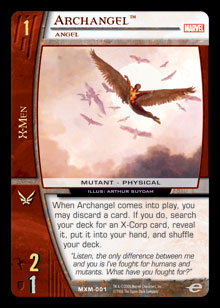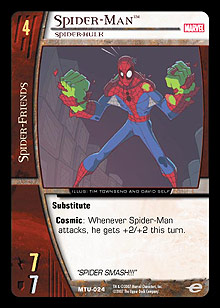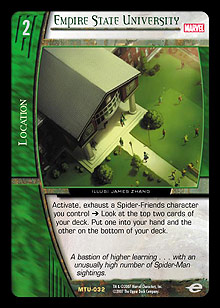If you haven’t been keeping up with my articles over the last few weeks, I have been focusing on deck construction for different formats. With the City Championships around the corner, having a strong deck to take and dominate with is probably first and foremost in your minds. Still, a strong deck is only part of the answer. The other part, arguably, is harder to attain and even more difficult to maintain. Of course, I am speaking of play skill.
Often, too much emphasis is put on deck construction and not enough on solid play skills. Vs. System is the premier trading card game, and there is a reason for that: it takes a good deal of skill to be competitive. One of the most skill-intensive facets of this game is the formation step. I have written about the importance of this step before, but given the recent change in Organized Play to focus on casual play, beginning players really need to have a good understanding of what this step is, why it’s important, and how it can help you win the game.
Formation Step: The Beginning and the End
If you talk to any professional Vs. players, they will invariably tell you that games are won and lost in the formation step. Even the most consummate professional can make a mistake in this all-important step.
 At Pro Circuit Atlanta, I was playing against Anand Khare in the semifinal match. It was the first game of the match, and it was intensely close. He was playing a deck that utilized Faces of Evil and Blackbird Blue to pump out a ton of low-cost characters with abnormally large ATKs. I was playing a Squadron Supreme deck and was able to get off an Other-Earth on a key turn to take Anand deep into the negatives. Due to the nature of his deck, however, he still had several characters that could attack back after I made all my attacks. After I passed my attack step, Anand began to calculate who should team attack into my characters and who he should leave to attack directly (assuming he was able to clear my board and I did not have a way to recover my characters). He announced a team attack of three characters, all of whom were in his support row. I sat for a second and then calmly asked if Archangel, Angel had range. The blood seemed to drain from his face, and he declared that if he hadn’t made that mistake, he would have won that game. Whether he would have won that match is irrelevant—the lesson learned here is that a top-level pro can still make mistakes during formation.
At Pro Circuit Atlanta, I was playing against Anand Khare in the semifinal match. It was the first game of the match, and it was intensely close. He was playing a deck that utilized Faces of Evil and Blackbird Blue to pump out a ton of low-cost characters with abnormally large ATKs. I was playing a Squadron Supreme deck and was able to get off an Other-Earth on a key turn to take Anand deep into the negatives. Due to the nature of his deck, however, he still had several characters that could attack back after I made all my attacks. After I passed my attack step, Anand began to calculate who should team attack into my characters and who he should leave to attack directly (assuming he was able to clear my board and I did not have a way to recover my characters). He announced a team attack of three characters, all of whom were in his support row. I sat for a second and then calmly asked if Archangel, Angel had range. The blood seemed to drain from his face, and he declared that if he hadn’t made that mistake, he would have won that game. Whether he would have won that match is irrelevant—the lesson learned here is that a top-level pro can still make mistakes during formation.
I tell you this story to illustrate how easy it is to have a “brain fart” and make a mistake in a premier event. In order to be a competitive player, you have to be on the ball the entire match, not just in the attack and recruit steps. Just as important is the ability to recover from those mistakes. This topic really should have its own article, but when you make a mistake, never give up. If you resolve yourself to a defeatist attitude, your opponent has already won. Remember—this game is difficult. If you are capable of making a mistake, so is your opponent!
Formations 101
Before I give you a rundown of advanced concepts in formations, we should at least, for the new players, cover the basics. Also, it never hurts to remind yourself why we do things during certain phases, so while this may be review for some, consider it prep for your next test . . . I mean “match.”
Characters with range – These are characters who can make attacks from either your front or support row.
Characters with flight – These are characters who can attack your opponent’s front or support row characters. Characters that only have flight are limited to attacking from your front row.
Characters with both flight and range – Essentially, these characters can attack any character on the board, regardless of their row placement.
I realize that these are very easy concepts, but when we all started out as rookie Vs. players, this was the foundation upon which we built complex strategies. If we don’t remember the past, we are doomed to repeat it, right?
Formation Considerations
Generally, there are two concepts that you are trying to employ when you enter your formation step: maximizing endurance loss for your opponent and minimizing endurance loss for yourself. The goal of every strong player is to find the right balance between these two concepts.
Maximizing Endurance Loss for Your Opponent
For the most part, this is just a fancy way of saying “trying to win the game,” as the most conventional way of winning the game is reducing your opponent’s endurance level to 0. If this was your only consideration during formations, you would generally put everyone who did not have range in the front row and then pass to your opponent. Unfortunately, things are not that cut-and-dried.
Minimizing Your Endurance Loss
Reinforcement is the most efficient way to minimize your endurance loss. The ability to reinforce is one of the most important facets of game play. Unfortunately, it is in direct conflict with attacking your opponent, as it requires you to exhaust an adjacent support row character. If you are exhausting a character to stop the breakthrough an opponent is doing, you are giving up theoretical damage that the character who is providing reinforcement could inflict (i.e. that character will not be able to attack). Sometimes this is not an issue if you know that your opponent is going to be attacking into that character, but when the situation isn’t as clear-cut, you must balance your offensive and defensive options.
Knowing Is Half the Battle
If the complications associated with the formation step were limited to what I already discussed, then it wouldn’t take that long to master. Unfortunately, the little we have discussed has only scratched the surface of the all-important step. How you choose to form up your characters can give away information that you would prefer to keep secret from your opponent.
 How is this so? Here is the most rudimentary example I can think of: You control Spider-Man, Spider-Hulk (and no other characters), and you place him in your support row. You spend very little time making this decision and pass. What information have you passed on to your opponent?
How is this so? Here is the most rudimentary example I can think of: You control Spider-Man, Spider-Hulk (and no other characters), and you place him in your support row. You spend very little time making this decision and pass. What information have you passed on to your opponent?
First off, you put a character that does not have range in the support row; this tells your opponent either you made a mistake or you have a card that will allow said character to attack from the support row (in the situation I provided, reinforcement is not really a consideration since Spider-Man is alone in the support row). Seems pretty basic, right? Well, the next step would be to analyze what cards you have played so far. If you have played combat modifiers that give range to a character, your opponent might now expect a surprise attack. Also, the speed at which you go through the formation step might indicate to your opponent that you either failed to notice the lack of range or that you are trying to feign a mistake and force him or her to walk right into a trap.
I realize that this is a very basic example and doesn’t get into complex usage of plot twists that may complicate the matter, but for a beginner’s lesson, it gets the job done. The ability to mask these signals and read them when your opponent lets them slip is not easy to come by, but through work, it is attainable.
First, you need to know your cards. This can be difficult for a new player, so if that is your situation, start with the new stuff and work backwards. Next, play the game. A lot. The more you play, the more you get to see situations where certain cards could potentially impact a game. If you work on your card knowledge as well as familiarizing yourself with situations where a certain card could be beneficial, you will be able to recognize the signals that an opponent may give in regards to possible cards he is holding, as well as minimizing the amount of information that you are giving to your opponent.
Activation and Payment
This topic gets its own section because of the sheer volume of cards with activated or payment powers that see play. They don’t complicate things too much, and often, they can throw your opponent off if you happen to have some tricks up your sleeve.
Take the previous situation, for example. You still control Spider-Man, Spider-Hulk, but before you go to your formation step, you recruit a Flamethrower on him. During your formation step, you still leave him in your support row and then pass to your opponent. Now, in addition to the considerations that were laid out before, Spider-Man is actually showing your opponent that even if you don’t have a plot twist or something else that gives him range, he can still cause your opponent to lose endurance. It’s this consideration that will likely make an opponent think long and hard with regard to his or her own formation, because he or she doesn’t want to fall into a carefully-laid trap.
This is a fairly simple example, but you can see that even in the most basic situation, there were no fewer than three potential scenarios that your opponent had to consider:
- You have a plot twist that will enable Spider-Man to attack from the support row.
- You are simply going to use the Flamethrower’s ability to burn your opponent.
- You have some other plot twist / effect that will utilize Spider-Man (such as a plot twist or location that calls for exhaustion of a character).
As you identify key plot twists and effects that can give characters other uses than simply attacking and reinforcing, you will find that the myriad of situations that you need to prepare for can seem overwhelming.
Getting Tricky
Now that you have a general understanding of what the formation step is and what kind of decisions are present, we can start delving into the cards that can impact formations.
Poker Night – I was totally owned by this card in Draft. Being able to provide reinforcement in a pinch is quite useful. Add in the fact that this card can draw you a card if it is played from your row, and I could see it showing up in some control-oriented decks.

Empire State University
– This is a card that will give utility to a character that is resting in the support row without range. I fully expect this card to be in a variety of decks, as its power is hard to deny. While it may not directly impact your opponent, if you are playing this card, you need to find a way to utilize it while also planning on attacks your opponent may propose.